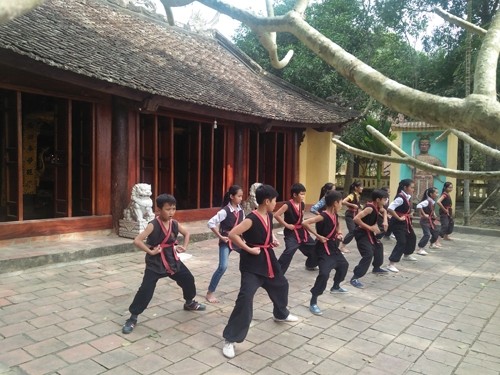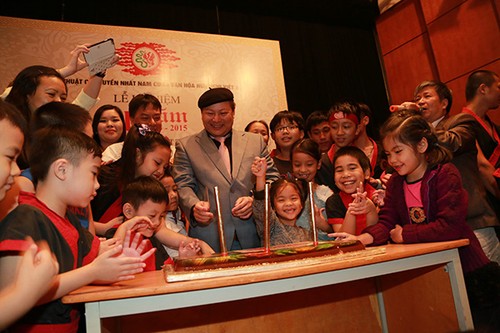“Nhat Nam improves both our physical and our emotional strength. It reminds us of our roots and the fight against northern invaders. Nhat Nam improves our health, bolsters our courage, and embodies the Vietnamese principle of using weakness to overcome strength. I believe we should promote Nhat Nam martial arts along with the other cultural and historical values of Vietnam to strengthen national security”, said Dang Van Gioi.
“Like other young people, I’m eager to learn about the roots of Vietnamese traditional martial arts. Nhat Nam is one of the pure Vietnamese martial arts. So young people should practice it with pride to preserve our tradition and intangible cultural heritage”, said Phung Van Hao.
 A Nhat Nam class (Photo: quehuongonline.vn) A Nhat Nam class (Photo: quehuongonline.vn) |
The Nhat Nam martial arts school has existed in Vietnam since the thirteenth or fourteenth century. It is said that Nhat Nam derived from a martial art called “Het” or “Hec” in today’s Thanh Hoa, Nghe An, and Ha Tinh province. The name “Nhat Nam” was adopted after all the sects of Hét martial arts were unified. Nhat Nam was designed to suit the physical characteristics of the Vietnamese. Master Dao Trung Hieu, Head of the Yen Hoa and Viet Hung Nhat Nam martial arts club, said: “Nhat Nam was created just for Vietnamese. The essence of Nhat Nam is the principle of weakness overcoming strength and it’s the basis of all moves and exercises. This means the martial artist uses avoidance techniques to make the opponent’s attack fail. Then, he uses the opportunity to strike a weak point on the opponent’s body really hard”.
Nhat Nam was once popular in every village. People learned Nhat Nam not as a career path but to train their body, perform at cultural festivals, and defend their homeland against invaders. Martial arts master Ngo Xuan Binh revived Nhat Nam in 1983. Master Hieu said: “As professor and academician Ngo Xuan Binh said, martial arts are not about violence, but a path to perfection and the harmony of the individual and the community. Practicing Nhat Nam expresses our gratitude to martial art guru. We follow the path that our master chose and dedicated his life to in the hope of preserving our heritage. As his students, we are determined to preserve Nhat Nam for future generations and we expect others to come to Nhat Nam with this same spirit”.
 Master Ngo Xuan Binh and Nhat Nam students (Photo:cand.com.vn) Master Ngo Xuan Binh and Nhat Nam students (Photo:cand.com.vn) |
The Yen Hoa Nhat Nam martial arts club in Hanoi is free of charge to students. It was founded by master Dao Trung Hieu, a journalist and writer, and master Pham Hai Hung, who now works for the Hanoi Department of Civil Engineering. Practitioners of Nhat Nam for nearly 30 years, they are dedicated to bringing it to more people. Master Hung said: “We believe we have a responsibility to promote this tradition and hand it down to the younger generation. That’s why, we decided to found this martial arts club. We have received financial and emotional support from the authorities of Yen Hoa ward for the club’s operation. Students come here to practice every Wednesday and Saturday afternoon”.
Martial arts trains the mind as well as the body. The ultimate goal is to instill moral principles. Nhat Nam masters teach their students the importance of morality and moderation.